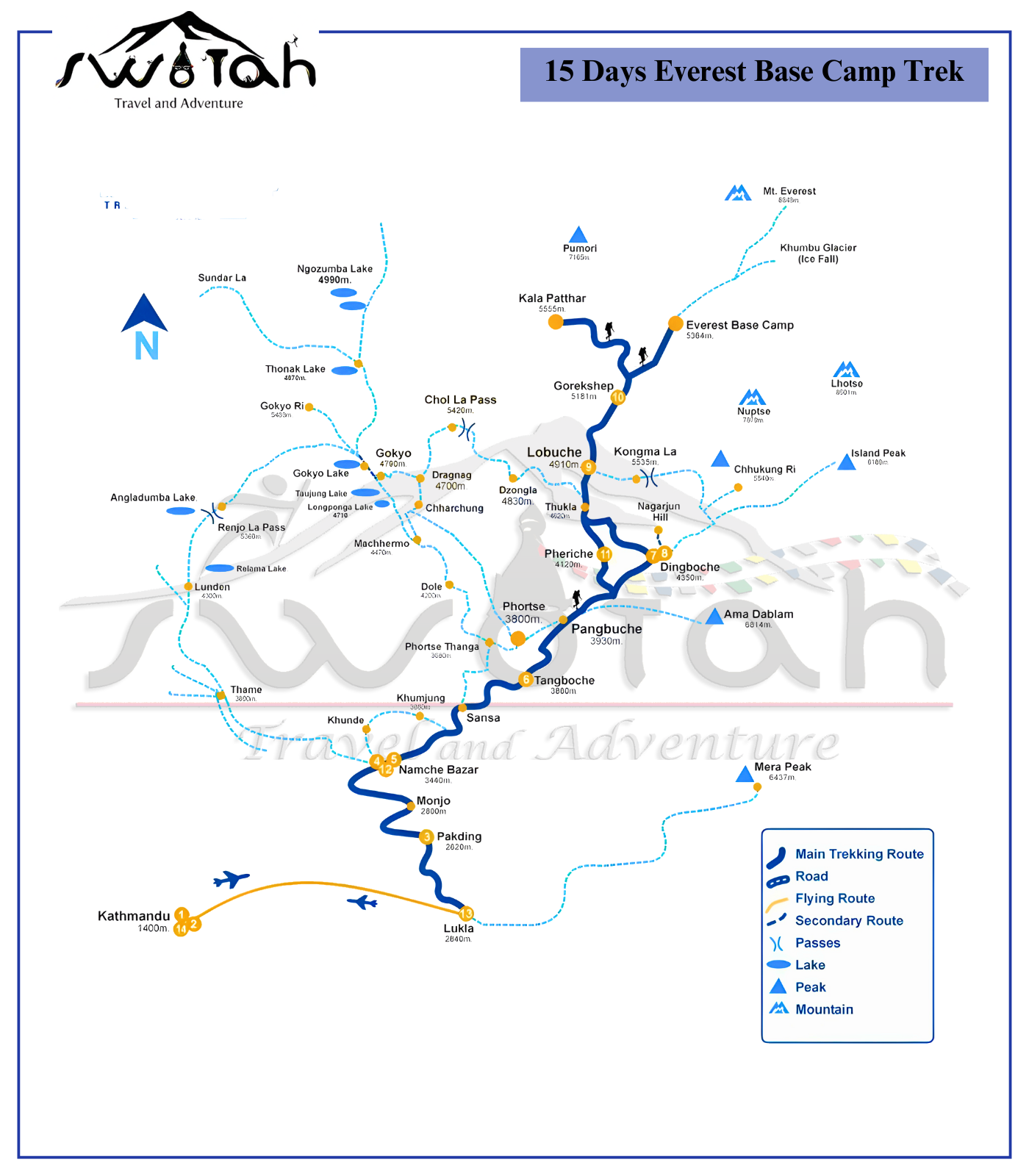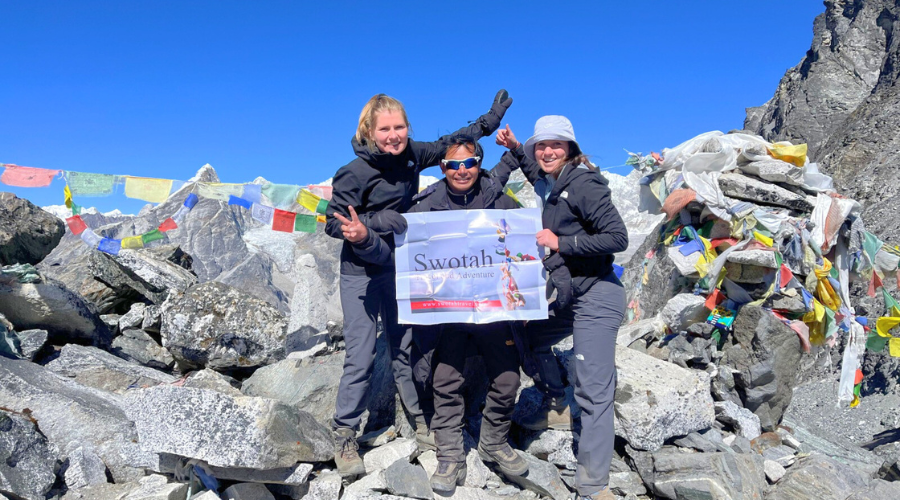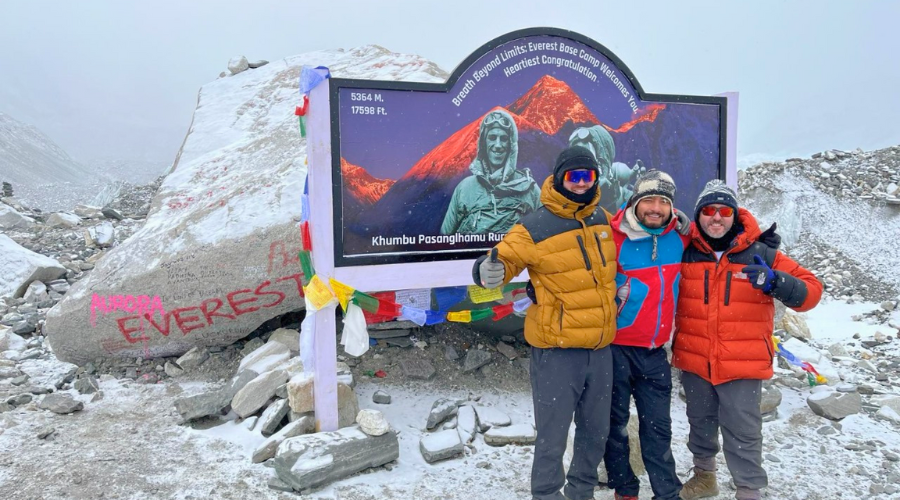
Challenges of Everest Base Camp Trek: Weather, Permits, and Difficulty

Challenges of Everest Base Camp Trek: Weather, Permits, and Difficulty
Kanti Khadka
5164
21, 11 2019
Everest base camp falls under one of the most popular treks in Nepal. Gateway to the highest mountain in the world, Everest base camp trek is the most sought-after trekking destination in the world. The base camp flaunts magnificent up-close views of Mount Everest. In addition, it also opens up splendid views of other peaks such as Mt.Lhotse, Cho Oyu, Makalu, and many more.
The trek is very diverse, with varying landscapes of lush green meadows and dense forests to close-up views of pristine mastiffs. Passing through Sherpa villages, the trek's difficulty depends upon the number of days and the route. It usually takes 2 weeks to complete the journey; thus, anyone physically fit can complete the trek to Everest base camp.
Altitude is often a problem on this trek. The trail route elevates up to 5,364m, and the risks of altitude sickness are very high if the length of the trek is inadequate without ample time for acclimatization.
The Everest base camp trek is the complete blend of the thrilling trail with beautiful landscapes leading to spectacular scenery. Here is the complete guide to the Everest Base camp trek.
Everest Base Camp Trek Map

Photo: Everest Base Camp Trek Map
Weather
Everest Base Camp is in the mountainous part of Nepal. The altitude is quite high while trekking to Everest Base Camp, up to 4000 meters, resulting in weather variations in various places along the trek. The higher the elevation, the more unpredictable the weather gets. Thus, it's wise to start preparing according to elevation.
Best Time To Travel To EBC
Everest has four seasons- summer, spring, autumn, and winter.
Summer
June, July, and August mark the start of summer in EBC. The trek's highest point's lowest temperature in the summer is almost exactly zero degrees. This temperature is nice, given that you will be in the Base Camp of the world's tallest peak.
The EBC trek is less well-liked in the summer than it is in the autumn or spring since the rainy season in Nepal falls during the summer. However, if you want to plan your trip with monsoon in mind, make sure you have the right equipment. A summer trek in EBC might then be a pleasant experience.
Winter
December, January, and February are the months when winter occurs in EBC. During this season, it is common to experience a minimum amount of rainfall in the Everest region. This season also captures the most stunning pictures of the mountains. However, due to heavy snowfall, some trekking routes are closed during this season.
Moreover, some places on the trek have a minimum temperature of -20 degrees in the winter. Therefore, winter treks in the Everest region are less popular. But for people who wish to trek during the offseason in altitude, this is a great option.
Autumn
Autumn in Everest Base Camp occurs in September, October, and November. The Autumn journey to EBC is well-liked because of the temperate weather and very minimal probability of rain. The weather is comfortable at this time. This indicates that the midday temperatures are comfortable for hiking. The overnight temperatures are not very chilly.
Spring
Right after the end of the winter in EBC, the spring season begins. This season falls in the month of March, April, and May. The Sagarmatha National Park is full of rhododendron blooms, lush green forests and picturesque landscapes. Similarly, the mountains, glaciers and villages in this region flaunt their best color during this season, making it the perfect season for photography in EBC.
Altitude
The classic Everest Base Camp trek starts from Lukla, which is at an altitude of 2800 meters. From Lukla, various overnight stops will be made, and the trek will eventually be completed in around two weeks.
Mostly, the altitude of the places in the EBC trek is more than 3000 meters. More interestingly, there are various trekking options in the Everest region. So, trekking there might take more or less 2 weeks, depending on the trekking packages.
So, with different trekking packages comes variations in places along the trek and altitudes as well.
There are some mountain passes you cross while trekking in the Everest region.
|
Places |
Altitude |
|---|---|
|
Lukla |
2800 m |
|
Namche Bazaar |
3438 m |
|
Khumjung |
379 m |
|
Tengboche |
3860 m |
|
Gorak Shep |
5164 m |
|
Everest Base Camp |
5364 m |
|
Kala Pathar |
5545 m |
|
Gokyo |
4750 m |
Permits Required
While trekking to Everest Base Camp in Nepal you'll need the following permits:
-
Sagarmatha National Park Entry Permit: NRs 3000 or $33 per person
-
Khumbu Rural Municipality Permit: NRs 2,500 $23 per person
-
The Sagarmatha National Park Entry Permit can be purchased in Kathmandu at the Tourist Information Center or Monjo while on the trek.
The Khumbu Rural Municipality Permit is available from a counter at Lukla or Monjo.
Don’t forget to get a receipt.

Level of Difficulty
Every trekker's major concern about Everest Base Camp is whether the trek is doable. The difficulty of the EBC trek is determined by several factors, such as altitude, trekking hours, and the season.
Longer Everest trekking routes in Nepal can take up to a month to complete, while shorter trekking routes can be completed in a week. Trekking in the mountains for a month is quite strenuous. But, to lessen your worries, Everest Base Camp trek is only two weeks long. This makes it moderately difficult in terms of the number of trekking days.
While on the EBC trek, regular trekking is of around 5-6 hours a day. Breakfast will be served in a teahouse/ lodge in the morning and you set out for trekking and trek for around 3 hours before lunch. After lunch and taking some rest, the trek continues for around 3 hours before reaching the overnight stop.
Altitude is another factor contributing to the difficulty of the trek. There are various ways in which you can prepare for altitude sickness. Remember to go slowly in your treks and spend adequate time to acclimatize to the altitude.
Therefore, considering all the influencing factors, the EBC trek has a moderate difficulty level.
Train Your Body For The Everest Trek
You do not have to be a hardcore athlete to be able to trek to EBC. But you have to be fit enough to enjoy the long walks and wake up without a sore body. Some of the ways you can train your body are:
- Start exercising about 4-6 weeks before the trek.
- Do Cardio exercises like running, walking, swimming or cycling.
- Carry a backpack while doing cardio exercises.
- Strengthen your muscles by doing squats, pull-ups, deadlifts, etc.
- Avoid over-exercising. The aim is to increase physical stamina and lung capacity.
Food and Accommodation
Accommodation on the Everest Base Camp trek is quite varied, with a mix of traditional tea houses, more modern guesthouses, and commercial hotels. The general scenario is that the higher up you go, the lower the standard of accommodation. There is still one golden rule, though. All the accommodations require that you eat all your meals there if you stay there, too.
Teahouses are generally owned by local families, but things have been getting more commercial recently. They own anything between 3 and 15 rooms. The rooms are basic, with thin plywood walls. Some have private bathrooms, while nearly all have shared bathrooms. Some will have squat toilets, while others are Western. They have a large communal dining area. Costs for a teahouse room are around $2-5.
Charging: If you have a private room with a bathroom, you'll probably be able to charge your electronics for no extra charge. However, for shared bathrooms, your room will only have a light switch and nothing more. You have to charge your electronics in a common room. The cost of charging a battery ranges from $3-6.

Essential Gears
You will need several types of equipment for the trek. The list below is generous, and you may include or avoid items according to your needs.
The trekking gear you must have:
- Heavyweight gloves or mittens with a waterproof shell outer
- Down vest and/or jacket (optional)
- Fleece or wool trousers/pants
- Trekking/Hiking boots with spare laces
- Thick, warm wool hiking socks
- Footwear for around camp, for example, running shoes and/or sandals
- Gaiters (optional)
You will also need the following during the trek.
- Thermal tops
- Fleece jacket or pullover
- Windcheater jacket (optional)
- Waterproof shell jacket
- Thermal gloves
- Underwear
- Shorts
- Cotton trousers/pants
- Thermal bottoms
- Sun hat or scarf or Hat
- T-shirts
- Socks
- UV protected sunglasses
- Sleeping bag rated to 0 degrees (3/4 season)
- Headlamp, spare bulbs & batteries
- Small padlock to lock trek bag
- Plastic bags
- Daypack (35-40 litres/2500-3000 cubic inches)
- Camping mattress
- Water bottles
- Small wash towel
- Footwear
- Waterproof shell trousers/pants (preferably breathable fabric)
- Toiletries
- Basic first aid kit
Everest Base Camp Cost
There are various kinds of expenses while trekking in Everest Base Camp. The cost of EBC trek includes the cost of flights, accommodation, food, gear, travel permits, insurance, a guide, and other miscellaneous costs.
The flight to Lukla from Kathmandu costs about 177$. If you wish to reach EBC through Jiri, then you won’t have to take a flight, which will reduce the cost of the flight. The price of a flight from Lukla to Kathmandu is also similar.
The price of accommodation in the EBC trek depends on the comfort and facilities provided. There are tea houses along the trekking trails, which are quite cheap. On the other hand, right next to tea houses, there are luxurious hotels. So, if you book the Everest Base Camp luxury trekking package, your cost will be higher.
In addition, you should expect to pay higher charges for accommodation as you go to higher altitudes.
Guides and porters are a must while on a trek. Their prices vary from 20 – 40 US$. Additional miscellaneous expenses may occur while charging your electronic gadgets and tipping porters/ guides/ waiters.
Routes and Itinerary
The Everest Base Camp trek can be completed in different ways. It all depends upon the places you want to see along the way. This is the classic itinerary to the Everest Base Camp:
|
Days |
Itinerary |
Max. Altitude |
Distance Covered |
Trekking Hours |
|
1 |
Arrival in Kathmandu |
1400 m |
|
|
|
2 |
Kathmandu sightseeing |
1400 m |
|
|
|
3 |
Kathmandu - Lukla - Phakding |
2800 m |
8 km |
3-4 hrs |
|
4 |
Phakding - Namche Bazaar |
3438 m |
11 km |
5-6 hrs |
|
5 |
Namche Bazaar acclimatization |
3438 m |
|
|
|
6 |
Namche Bazaar - Tengboche |
3870 m |
10 km |
5-6 hrs |
|
7 |
Tengboche - Dingboche |
4360 m |
9 km |
5-6 hrs |
|
8 |
Dingboche - acclimatization |
4360 m |
|
|
|
9 |
Dingboche - Dughla |
4600 m |
4 km |
3-4 hrs |
|
10 |
Dughla - Lobuche |
4940 m |
4 km |
2-4 hrs |
|
11 |
Lobuche - Gorak Shep- EBC - Gorak Shep |
5364 m |
13 km |
6-7 hrs |
|
12 |
Gorak Shep - Kala Pathar - Pheriche |
5545 m |
16 km |
7-8 hrs |
|
13 |
Pheriche - Namche Bazaar |
3440 m |
20 km |
6-7 hrs |
|
14 |
Namche Bazaar - Lukla |
2860 m |
19 km |
6-7 hrs |
|
15 |
Lukla - Kathmandu |
2860 m |
|
|
|
16 |
Departure from Kathmandu |
1400 m |
The number of days you spend in the places mentioned above can be extended if you want to. You can contact the travel agency whose services you are going to receive to know how they can customize a trip for you.
NEWSLETTER SIGNUP
Sign up to receive our trip ideas and travel offers!
Get updates and Exclusive Offers up to 20% Discount








